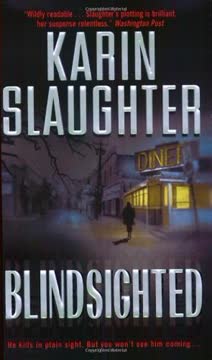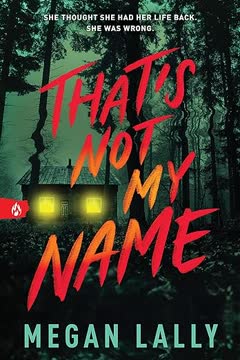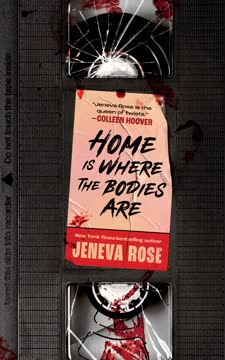Plot Summary
Sisters and Secrets
Sara Linton, the town's medical examiner and pediatrician, shares a close but complicated relationship with her very pregnant sister, Tessa. Their banter is laced with affection and rivalry, hinting at deeper wounds and secrets. Sara's life is split between her demanding jobs and her unresolved feelings for her ex-husband, Jeffrey, the local police chief. Tessa's pregnancy and Sara's inability to have children add emotional complexity. Their Sunday outing is interrupted by a call from Jeffrey, drawing Sara into a new case and setting the stage for the collision of personal and professional crises.
Riverbed Revelations
Sara and Tessa arrive at a dried-up riverbed where a young man's body lies beneath a bridge, apparently a suicide. The scene is disturbing: the victim's body is mutilated in ways that don't fit a straightforward suicide. Sara's forensic instincts are piqued by inconsistencies—unusual injuries, a lack of expected trauma, and a recent scar. The presence of racist graffiti on the bridge and the victim's connection to the local college hint at deeper undercurrents. The arrival of Lena Adams, a former detective now working campus security, and her tense interactions with Jeffrey and Sara, foreshadow the tangled relationships and secrets to come.
Tessa's Nightmare
While Sara investigates the riverbed, Tessa wanders into the woods and is viciously attacked. Sara finds her sister bleeding and near death, stabbed multiple times. The trauma is compounded by the loss of Tessa's unborn child. The attack devastates the Linton family, igniting guilt and blame between Sara, Jeffrey, and Tessa's parents. The violence feels random yet targeted, and the proximity to the earlier suicide raises questions about a possible connection. The emotional fallout is immediate and raw, as Sara's professional detachment crumbles in the face of personal tragedy.
Lena's Descent
Lena Adams, still reeling from her own past trauma and the loss of her sister, is adrift. Her demotion to campus security is a daily humiliation, and her self-destructive tendencies—alcohol, risky relationships—intensify. Lena's interactions with Ethan, a troubled student with a violent past, blur the lines between victim and perpetrator. Her inability to trust or be trusted isolates her further, and her connection to the case becomes increasingly suspect. Lena's psychological unraveling is mirrored by her physical injuries and her fraught relationships with former colleagues.
Campus Shadows
The investigation turns to the college, where a culture of secrecy, drug use, and academic ambition festers. The dead student is identified as Andy Rosen, the son of a campus counselor and a research scientist. His history of mental illness, drug abuse, and family dysfunction complicates the case. Lena's fingerprints are found in Andy's room, and a pair of women's underwear raises suspicions about her involvement. Meanwhile, another student, Ellen Schaffer, is found dead in an apparent suicide, but forensic evidence suggests murder. The campus becomes a labyrinth of suspects, motives, and hidden connections.
The Web Tightens
As the body count rises, so does the pressure on Jeffrey and Sara. The deaths of Andy Rosen, Ellen Schaffer, and later, William "Scooter" Dickson, all staged as suicides, point to a calculating killer. Lena's erratic behavior and her relationship with Ethan draw increasing scrutiny. The investigation uncovers a web of academic rivalry, drug dealing, and personal vendettas. Sara's autopsies reveal subtle but crucial evidence—needle marks, aspirated teeth, and staged scenes—while Jeffrey's interviews expose the toxic underbelly of the college community.
Deaths and Doubts
Sara's meticulous autopsies challenge the suicide verdicts, revealing evidence of murder in at least one case. The forensic details—paralytic drugs, staged injuries, and missing personal items—suggest a killer with medical knowledge and access. Lena's involvement becomes more ambiguous as her fingerprints and personal items are found at multiple scenes. The trust between Sara and Jeffrey is strained by professional disagreements and personal pain, while Lena's self-destruction accelerates. The community reels from the violence, and the investigation is mired in doubt and fear.
Lena Under Fire
Lena is arrested after Chuck Gaines, the campus security chief, is found murdered with her knife at the scene. She is battered, traumatized, and refuses to defend herself, insisting she "fell." The evidence against her is damning—her fingerprints, her history, her proximity to the victims. Sara, forced to perform another rape kit on Lena, is torn between empathy and professional duty. Jeffrey, struggling with his own guilt and anger, is forced to confront the possibility that Lena is both victim and perpetrator. The emotional stakes are at their highest as Lena's fate hangs in the balance.
The Truth Unravels
The investigation's breakthrough comes when Richard Carter, a faculty member with a history of abuse and resentment, confesses to the murders. Driven by jealousy, a desire for recognition, and a twisted sense of loyalty to his father, Richard killed Andy Rosen to protect a stolen research project, murdered Ellen Schaffer to silence a witness, and attacked Tessa in a desperate search for evidence. His confession is chilling in its rationality and lack of remorse. Lena, nearly killed by Richard, survives only through the intervention of Frank, her former partner.
The Final Confession
Richard's confrontation with Lena is the novel's emotional and narrative climax. He tries to manipulate her into complicity, offering to "help" her escape her abuser by killing Ethan. Lena, battered but defiant, fights back, and the standoff ends with Richard's death at Frank's hands. The truth about the murders, the academic theft, and the personal betrayals is finally exposed. The community is left to reckon with the damage, and the survivors must find a way to move forward.
Aftermath and Reckoning
With the killer dead and the case closed, the characters are left to pick up the pieces. Lena is released, but her future is uncertain—her job gone, her relationships fractured, her trauma unresolved. Sara and Jeffrey, both changed by the events, struggle to reconnect. The college faces scandal and investigation, and the Linton family begins the slow process of healing. The novel's resolution is bittersweet, acknowledging the scars left by violence and the difficulty of forgiveness.
Healing and Hope
In the final chapter, the focus shifts to recovery and the tentative steps toward hope. Sara and her family gather around Tessa as she begins to heal, both physically and emotionally. Sara and Jeffrey confront their own relationship, questioning whether love can survive betrayal and pain. Lena, offered a chance at redemption, must decide whether to accept help or continue down a path of self-destruction. The novel ends on a note of ambiguity, recognizing that healing is a process, not a destination, and that hope is both fragile and necessary.
Characters
Sara Linton
Sara is the emotional and moral center of the novel, balancing her roles as medical examiner, pediatrician, sister, and daughter. Her deep empathy is both her strength and her vulnerability, as she is drawn into the suffering of those around her—especially Tessa and Lena. Sara's inability to have children adds a layer of longing and loss to her character, and her relationship with Jeffrey is fraught with unresolved pain and desire. Professionally, she is meticulous and principled, but the personal nature of the crimes challenges her objectivity. Sara's journey is one of confronting her own limitations, guilt, and the need for forgiveness.
Jeffrey Tolliver
Jeffrey, the police chief, is a man defined by his need to protect and control. His past infidelity and the resulting divorce from Sara haunt him, fueling both his determination and his insecurity. Jeffrey's investigative instincts are sharp, but his personal involvement in the case—especially Tessa's attack and Lena's downfall—clouds his judgment. He is both compassionate and flawed, capable of violence and tenderness. Jeffrey's arc is one of reckoning with his own failures and learning to let go of the illusion of control.
Lena Adams
Lena is a study in trauma and resilience. Once a promising detective, she is now adrift, her life shattered by rape, her sister's murder, and professional disgrace. Lena's self-destructive behavior—alcohol, risky sex, antagonism—masks a deep well of pain and a desperate need for connection. Her relationship with Ethan is both a symptom and a cause of her unraveling. Lena's psychological complexity is central to the novel, as she oscillates between victim and suspect, loyalty and betrayal. Her journey is one of survival, but not yet of healing.
Tessa Linton
Tessa, Sara's younger sister, is the novel's most tragic figure. Her pregnancy, optimism, and vulnerability make her attack all the more devastating. Tessa's suffering is the catalyst that forces the other characters to confront their own failings and fears. Her relationship with Sara is both loving and fraught, and her loss reverberates through the family and the community. Tessa's arc is one of endurance and, ultimately, the possibility of recovery.
Ethan White/Green
Ethan is a complex antagonist, a young man with a violent past, racist tattoos, and a desperate need for control. His relationship with Lena is toxic, oscillating between attraction and abuse. Ethan's presence in the novel forces Lena—and the reader—to confront uncomfortable truths about trauma, complicity, and the cycle of violence. He is both a product and a perpetrator of abuse, and his fate is left unresolved, a lingering threat and a symbol of unfinished business.
Richard Carter
Richard is the novel's true villain, a faculty member consumed by resentment, jealousy, and a need for recognition. His history of abuse and neglect fuels his actions, as he kills to protect a stolen research project and to punish those he perceives as threats. Richard's psychological profile is chilling—rational, remorseless, and skilled at manipulation. His confession and final confrontation with Lena are the novel's climax, exposing the depths of his depravity and the consequences of unchecked ambition.
Jill Rosen
Jill is a campus counselor and the mother of Andy Rosen. Her professional competence masks a life of domestic abuse and emotional isolation. Jill's inability to protect her son or herself is a source of deep pain, and her interactions with Sara and Lena reveal the complexities of victimhood and survival. Jill's arc is one of gradual awakening, as she confronts the truth about her husband and her own complicity in the family's dysfunction.
Brian Keller
Brian is a research scientist whose ambition and emotional detachment have devastating consequences. His theft of Sibyl's research and his neglect of both his sons set the stage for the novel's central crimes. Brian's relationship with Jill is marked by abuse and control, and his inability to face his own failures makes him both a suspect and a victim. His arc is one of exposure and reckoning, as his secrets are brought to light.
Frank Wallace
Frank is Jeffrey's second-in-command and Lena's former partner. He is a steady, reliable presence, providing both practical support and emotional grounding. Frank's loyalty to Lena is tested by her self-destruction, but his intervention at the novel's climax is crucial. Frank represents the possibility of redemption and the importance of compassion in the face of suffering.
Nan Thomas
Nan, Sibyl's former partner, is a minor but significant character. Her home becomes a refuge for Lena, and her quiet support and practical kindness offer a model of healing and acceptance. Nan's presence is a reminder of the enduring power of love and the importance of chosen family.
Plot Devices
Interwoven Personal and Professional Crises
The novel's structure is built on the interplay between personal trauma and professional duty. Sara, Jeffrey, and Lena are all forced to confront their own wounds as they investigate the crimes, and the boundaries between victim, suspect, and investigator are constantly shifting. The use of multiple points of view allows the reader to experience the story's emotional complexity from different angles, deepening the sense of ambiguity and moral uncertainty.
Forensic Detail and Procedural Realism
Sara's autopsies are not just plot devices but windows into character and theme. The forensic details—needle marks, aspirated teeth, staged injuries—are both clues and metaphors for the hidden wounds carried by the characters. The procedural realism grounds the novel in a world where truth is elusive and evidence is always open to interpretation.
Psychological Suspense and Unreliable Narration
The novel's suspense is psychological as much as procedural. Lena's trauma and self-destruction make her both an unreliable narrator and a suspect, while Sara and Jeffrey's personal involvement clouds their judgment. The use of foreshadowing, red herrings, and shifting alliances keeps the reader—and the characters—off balance, heightening the sense of danger and uncertainty.
Social Commentary and Thematic Depth
Underlying the murder mystery is a rich vein of social commentary. The novel explores issues of racism, misogyny, academic ambition, and the legacy of abuse. The crimes are not just individual acts but symptoms of a broader sickness—one that infects families, institutions, and communities. The use of symbols—racist graffiti, stolen research, broken bodies—reinforces the novel's themes of power, control, and the cost of silence.
Analysis
Karin Slaughter's A Faint Cold Fear is a masterful blend of crime fiction and psychological drama, using the conventions of the procedural thriller to explore deeper questions of trauma, complicity, and the possibility of healing. The novel's power lies in its refusal to offer easy answers or tidy resolutions. Every character is wounded, every relationship is fraught, and every clue is open to multiple interpretations. The central mystery—who is killing the students, and why?—is ultimately less important than the emotional journeys of Sara, Jeffrey, and Lena. Slaughter's portrayal of trauma is unflinching, showing how violence ripples through families and communities, leaving scars that may never fully heal. The novel's social commentary is incisive, exposing the ways in which institutions—colleges, police departments, families—can both protect and destroy. In the end, A Faint Cold Fear is a story about survival: the courage to face the truth, the strength to ask for help, and the hope that, even in the aftermath of unimaginable pain, healing is possible. The lesson is clear: justice is not just about catching the killer, but about finding the strength to live on.
Last updated:
Review Summary
A Faint Cold Fear receives mixed reviews, with an average rating of 4.03. Readers praise Slaughter's character development and suspenseful plot, though some find the violence excessive. The story follows Sara Linton and Jeffrey Tolliver investigating apparent suicides at a college campus. Lena Adams' character arc continues to polarize readers. The book explores complex relationships and dark themes, with a shocking twist ending. While some consider it the weakest in the series so far, others find it compelling and emotionally engaging.
















